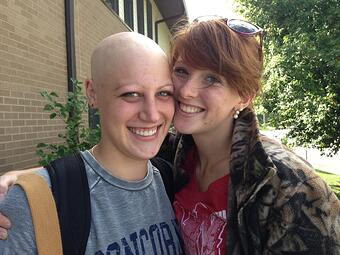A few weeks ago you heard the story of a strong young woman with alopecia universalis named Sydney Olson. This week we are excited to share some thoughts from her mother, Candace Olson.

I had the chance to speak with Candace where she was kind enough to share her story as well as numerous strategies she used to cope with her daughter's diagnosis.
Click through to read Candace's story, learn from the coping strategies that were most helpful for her, and hear her personal opinions on the media and hair-growth news.
Learning of Sydney's Alopecia
Candace first noticed alopecia symptoms in her daughter Sydney when she was 10, her nails were pitting and peeling. Their dermatologist did a small scalp biopsy and took nail clippings. The dermotologist encouraged Candace to use a topical lotion to be applied into Sydney's scalp, which she disliked.
"We would get up in the morning, wash her hair before school and struggle with some prescribed vitamin supplements. It was a real challenge."
Sydney never experienced the typical round patches of alopecia areata hair loss.  Eventually they decided to trim her hair to a short bob cut and discontinued the supplements because the doctors said [the lotion] was "worth a try and never a promise".
Eventually they decided to trim her hair to a short bob cut and discontinued the supplements because the doctors said [the lotion] was "worth a try and never a promise".
When Sydney was 18 she began to experience symptoms of alopecia for the second time, and this time the family was more aware of what was going on. "She came to me with hair from her shower saying “Mom! Look there is a smooth patch!”. She was scared and tears were flowing. I had a pit in my stomach." The family then tried treatment with Rogaine and steroid shots, however this did not have positive results.
Coping & Acceptance Strategies
When asked if she felt her daughter and herself coped similarly Candace recognizes that this simply was not true. "I will never know how hard it was and is for her to go through the loss of her identity, feeling like she is standing vulnerable to the world. On the flip side, I truly believe she will never get it that I had the need as a mom to 'fix' the alopecia problem."
Candace explained that during this process, she has watched Sydney go through the grieving, adapting her styles stage, coping, survival stage, to finally just now accepting. This process, she notes, has led her to help educate people in a crusade for alopecia awareness.
As far as how Candace herself coped and became an advocate for her daughter, here is an overview of what she shared with us:
- Crying privately, to stay strong for Sydney
- A great deal of time spent researching alopecia areata through websites, group blogs, and books before sharing information with Sydney
- Looking into wigs and other hair systems
- Ordering scarves, hats, special makeup and overall helping her adapt to her appearance
- Preparing Sydney's friends for a major change in her appearance
- Being stern in that she would not allow Sydney to curl up and let alopecia kill her dreams
- Created a safe social bubble on their farm to give her time to mourn and heal
Ultimately, it all came down to Candace putting aside her own emotions to make sure her daughter would make it through the major life change that is alopecia areata. She wanted Sydney to have her own path.
Other Resources and The Media
During this journey, Candace credits support groups (such as Bald Girls Do Lunch) that "connect people with facts" to be one of the most helpful resources she has found. She also mentions that online alopecia support groups where you must apply and be accepted to become a member are also real, very helpful resources. 
In contrast to the resources listed above, Candace expressed her frustration with ads shown in the media that can be seen as providing false hope of hair regrowth, in spite of unknown health repercussions, a huge drain on financial resources, and ultimately reinforce the message that a young girl needs hair in order to fit into today's society.
"I dislike the psychological and emotional drama it creates. There is no magic pill. There is nothing beneficial in an expensive drug being a “fix” for anything unless it is the answer for a life threatening disease. I have yet to see anything beneficial come from these reports about alopecia research released to the public."
Being a parent is a tough job to begin with and when your child has a disease, such as alopecia areata that job becomes even harder. Supporting your child during this time is crucial. Follow Candace's advice and see how you can help support not only your child, but those around you, prepare for the changes ahead, seek out trusted resources, and avoid "quick fixes" as they are usually too good to be true.

